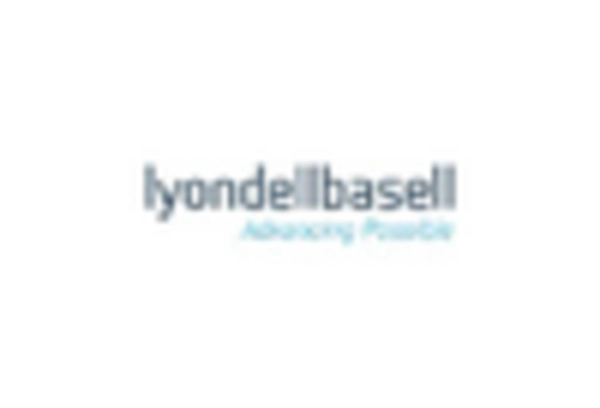Rising Construction Activities
The Middle East And Emea Elastomers Market is experiencing a notable surge in demand due to the increasing construction activities across the region. Countries such as the United Arab Emirates and Saudi Arabia are investing heavily in infrastructure projects, including residential, commercial, and industrial developments. This trend is likely to drive the consumption of elastomers, which are essential in various construction applications such as sealants, adhesives, and insulation materials. According to recent data, the construction sector in the Middle East is projected to grow at a compound annual growth rate of approximately 5.5% over the next few years. Consequently, the elastomers market is expected to benefit from this growth, as these materials provide durability and flexibility, essential for modern construction needs.
Expansion of Medical Applications
The Middle East And Emea Elastomers Market is witnessing a growing demand for elastomers in the medical sector. The increasing need for medical devices and equipment, driven by advancements in healthcare technology, is creating new opportunities for elastomer manufacturers. Elastomers are utilized in various medical applications, including tubing, seals, and gaskets, due to their biocompatibility and flexibility. The medical device market in the region is projected to grow at a compound annual growth rate of around 6% in the coming years. This growth is likely to enhance the demand for elastomers, as manufacturers seek materials that meet stringent regulatory standards while providing the necessary performance characteristics. The expansion of the medical sector is thus a key driver for the elastomers market.
Increased Focus on Automotive Innovations
The Middle East And Emea Elastomers Market is significantly influenced by the automotive sector, which is undergoing rapid innovations. The demand for lightweight and high-performance materials in vehicle manufacturing is on the rise, as manufacturers seek to enhance fuel efficiency and reduce emissions. Elastomers play a crucial role in this transformation, being utilized in various automotive components such as tires, seals, and gaskets. Recent statistics indicate that the automotive industry in the region is expected to grow at a rate of 4% annually, further propelling the demand for elastomers. As electric vehicles gain traction, the need for advanced elastomeric materials that can withstand higher temperatures and provide better performance is likely to increase, thereby benefiting the elastomers market.
Sustainability and Eco-Friendly Materials
The Middle East And Emea Elastomers Market is increasingly influenced by the shift towards sustainability and the use of eco-friendly materials. As environmental concerns gain prominence, manufacturers are exploring bio-based and recyclable elastomers to meet consumer demand for sustainable products. This trend is particularly evident in industries such as packaging, automotive, and construction, where the adoption of green materials is becoming a priority. Recent data suggests that the market for sustainable elastomers is expected to grow significantly, with a projected increase of 8% annually. This shift not only aligns with The Middle East And Emea Elastomers.
Technological Advancements in Production Processes
The Middle East And Emea Elastomers Market is benefiting from technological advancements in production processes. Innovations in manufacturing techniques, such as 3D printing and advanced compounding methods, are enhancing the efficiency and quality of elastomer production. These advancements allow for greater customization and the development of high-performance elastomers that meet specific industry requirements. As industries increasingly demand specialized elastomer products, the ability to produce them efficiently becomes a competitive advantage. The market is likely to see a rise in the adoption of these technologies, which could lead to improved product offerings and increased market share for manufacturers. This trend underscores the importance of continuous innovation in sustaining growth within the elastomers market.


















Leave a Comment